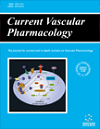- Home
- A-Z Publications
- Current Vascular Pharmacology
- Previous Issues
- Volume 2, Issue 4, 2004
Current Vascular Pharmacology - Volume 2, Issue 4, 2004
Volume 2, Issue 4, 2004
-
-
Non-Lipid Effects of Statins: Emerging New Indications
More LessAuthors: Aylin Yildirir and Haldun MuderrisogluStatins are beneficial both in the primary and secondary prevention of atherosclerotic vascular disease and acute events in a broad spectrum of patient subgroups. However, the observed clinical benefit with statin therapy is much greater than expected through the reduction of cholesterol levels alone. Clinical and experimental studies suggested that several antiatherosclerotic effects other than lipid lowering also contribute Read More
-
-
-
Inhibition of the Tissue Factor Coagulation Pathway
More LessAuthors: Paolo Golino, Lavinia Forte and Salvatore D. RosaIt is widely accepted that blood coagulation in vivo is initiated during normal hemostasis, as well as during intravascular thrombus formation, when the cell-surface protein, tissue factor, is exposed to the blood as a consequence of vascular injury. In addition to its essential role in hemostasis, tissue factor may be also implicated in several pathophysiological processes, such as intracellular signaling, cell proliferation, and inflam Read More
-
-
-
23Na Magnetic Resonance Imaging for the Determination of Myocardial Viability: The Status and the Challenges
More LessBy Michael HornThe determination of the extent of the non-viable tissue after myocardial infarction has a major impact on further treatment of patients. During acute myocardial infarction, total sodium content of the tissue is elevated. This is caused by discontinuation of ion homeostasis, edema formation and membrane rupture. The situation is a different one in the chronic phase of scar formation, where cell migration causes changes in t Read More
-
-
-
Antioxidant Therapy in Diabetic Complications: What is New?
More LessAuthors: Roberto D. Ros, Roberta Assaloni and Antonio CerielloIn diabetes oxidative stress plays a key role in the pathogenesis of vascular complications, and an early step of such damage is considered the development of an endothelial dysfunction. Hyperglycemia directly promotes an endothelial dysfunction inducing process of overproduction of superoxide and consequently peroxynitrite that damages DNA and activates the nuclear enzyme poly(ADP-ribose) polymerase. This proc Read More
-
-
-
The Role of Diffusion- and Perfusion-Weighted Magnetic Resonance Imaging in Drug Development for Ischemic Stroke: From Laboratory to Clinics
More LessAuthors: Turgut Tatlisumak, Daniel Strbian, Usama A. Ramadan and Fuhai LiIschemic stroke is a major cause of mortality and morbidity in industrialized countries and is almost always caused by occlusion of a cerebral artery by a clot. As the reversibly injured brain tissue evolves into irreversible infarction within a short period of time after onset of ischemia, it is extremely important and urgent to reverse the serious consequences of brain ischemia in the hyperacute phase when the ischemic brai Read More
-
-
-
Regulation of Hemostasis by Singlet-Oxygen (1ΔO2*)
More LessHemostasis is the system of generation and destruction of thrombi. It consists of coagulation and thrombolysis and has a plasmatic part and a cellular one, the latter being the thrombocytes and endothelial cells for coagulation and the polymorphonuclear granulocytes (PMN) for thrombolysis. Main products of PMN are oxidants of the hypochlorite / chloramine-type that can generate the nonradical excited oxidant Read More
-
-
-
Possible Non-Classic Intracellular and Molecular Mechanisms of LDL Cholesterol Action Contributing to the Development and Progression of Atherosclerosis
More LessAuthors: Ioanna Gouni-Berthold and Agapios SachinidisElevated low density lipoprotein (LDL) cholesterol (LDL-C) levels represent one of the most important risk factors for atherosclerosis and therefore cardiovascular morbidity and mortality. LDL-C operates at different levels and through various classic and non-classic mechanisms. For example, it has been recently shown that both native and oxidized LDL are potent growth factors for several cell types such as vascular smooth mu Read More
-
-
-
Mechanisms of Cardiovascular Changes in an Experimental Model of Syndrome X and Pharmacological Intervention on the Renin-Angiotensin- System
More LessAuthors: Roberto Miatello, Montserrat Cruzado and Norma RislerVarious cardiovascular risk factors and disease states similar to those present in type 2 diabetic patients also seem to be present in non-diabetic individuals. This cluster of risk factors has been called syndrome X, also known as metabolic cardiovascular syndrome or insulin resistance syndrome. Vascular wall components changes, including endothelial dysfunction and vascular smooth muscle cell (VSMC) migration and Read More
-
-
-
Vascular Stiffness: Measurements, Mechanisms and Implications
More LessAuthors: Yi-Xin Wang and Richard M. FitchAging is the dominant process altering vascular stiffness. Risk factors for cardiovascular disease, such as smoking, hypertension and diabetes mellitus, mediate their effects by altering the structure, properties, and function of the vascular wall and endothelial components. Increased vascular stiffness exerts greater afterload stress on the heart. The ability to detect and monitor changes in the physical properties of art Read More
-
-
-
Angiotensin II, Cell Proliferation and Angiogenesis Regulator: Biologic and Therapeutic Implications in Cancer
More LessAuthors: Elizabeth Escobar, Tatiana S. Rodriguez-Reyna, Oscar Arrieta and Julio SoteloAngiotensin II (ANG II) is the main effector peptide in the renin-angiotensin system. It is generated by the activation of Angiotensin I through the Angiotensin II Converter Enzyme (ACE II). ANG II has multiple physiologic effects that regulate vascular tone, hormone secretion, tissue growth and neural activity. It has systemic (endocrine) and local (paracrine and autocrine) effects, favoring cell growth and differentiation through fo Read More
-
Volumes & issues
-
Volume 23 (2025)
-
Volume 22 (2024)
-
Volume 21 (2023)
-
Volume 20 (2022)
-
Volume 19 (2021)
-
Volume 18 (2020)
-
Volume 17 (2019)
-
Volume 16 (2018)
-
Volume 15 (2017)
-
Volume 14 (2016)
-
Volume 13 (2015)
-
Volume 12 (2014)
-
Volume 11 (2013)
-
Volume 10 (2012)
-
Volume 9 (2011)
-
Volume 8 (2010)
-
Volume 7 (2009)
-
Volume 6 (2008)
-
Volume 5 (2007)
-
Volume 4 (2006)
-
Volume 3 (2005)
-
Volume 2 (2004)
-
Volume 1 (2003)
Most Read This Month
Article
content/journals/cvp
Journal
10
5
false
en


